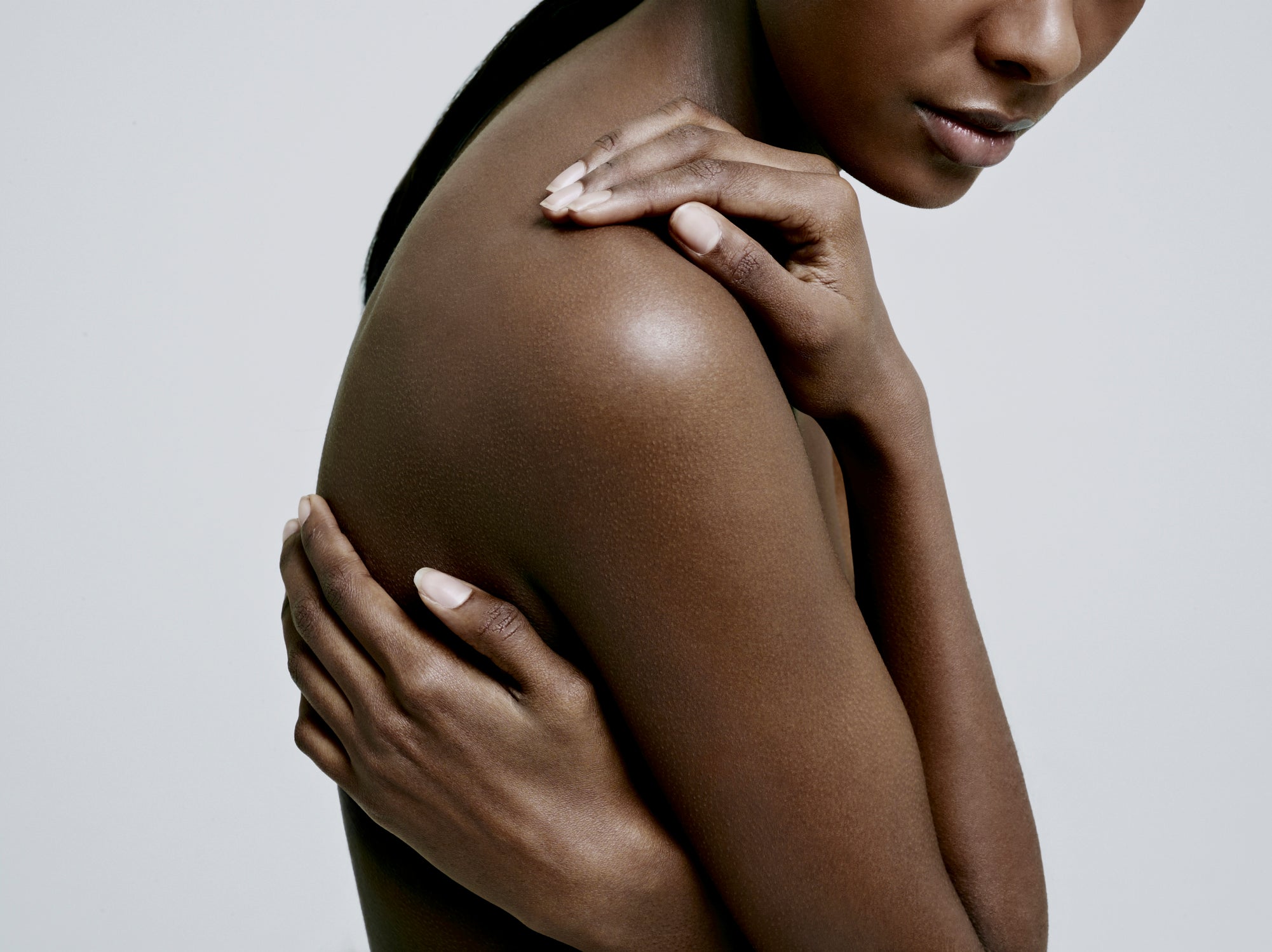
This article originally appeared on Health.
Growing up in the Caribbean, Amelia St. Ange spent hours in the sun playing tennis and hanging out on the beach. “My mom bought me sunscreen, but wearing it wasn’t on my priority list,” she admits. “I have dark skin, so I thought I was protected.”
But in 2012, St. Ange, then 22, was leaving a party with friends when she felt a stinging sensation at the back of her neck. “It felt like a bug had bitten me,” she recalls. When St. Ange asked her friends to check, they didn’t find a bug bite. But they did point out that she had a raised mole.
Amelia was surprised. She knew she had a mole on her neck, but she’d never been able to feel it before; it had always been perfectly flat against her skin. Two months into medical school at the time, St. Ange had learned enough about skin cancer to know that a raised mole was a sign of melanoma, the most dangerous kind of the disease. That’s when panic set in.
Finding out she had skin cancer
St. Ange searched online for signs of melanoma, but she didn’t find any pictures that matched her mole. A quest for “melanoma in dark-skinned women” found even fewer images. But she did uncover something alarming: that when melanoma is diagnosed in black women, it has usually already progressed to an advanced stage.
“That worried me so much more,” says St. Ange.
She went to see her family doctor, who reassured her that melanoma was unlikely because she had dark skin and was young. Still, St. Ange couldn’t get the possibility out of her mind. She decided to pay out of her own pocket to get a second opinion from a dermatologist. During the visit, the dermatologist numbed St. Ange’s skin, quickly removed the mole, and sent it off to a lab to be analyzed. A week later, St. Ange received a call to come back into the office.
“The doctor told me I had malignant melanoma,” she remembers. “For two hours, I sat in her office and cried.”
How melanoma strikes people of color
Skin cancer is the most common form of cancer. Two types, basal cell carcinoma and squamous cell carcinoma, account for about 5 million new cases each year. Melanoma is much less common, but it’s also a lot more lethal; while less than 1% of skin cancer cases are melanoma, it causes the vast majority of skin cancer deaths, according to the Skin Cancer Foundation.
Although most people affected by melanoma are white men over the age of 50, reports the Melanoma Research Foundation, it’s actually the leading cause of cancer death in women between 25 to 30 years old—and the second most common cause of death in women between 30 and 35.
There’s a dangerous misconception—one which St. Ange also believed—that skin cancer, particularly melanoma, only targets people with fair skin and light eyes and hair, not those of color. Supposedly, the additional melanin (pigment) darker-skinned people have offers more protection against the sun.
That’s true, to a point. On one hand, people with darker skin do have added protection from sun damage; a 2017 study published in the Journal of the American Academy of Dermatology found that the melanin in black skin provides an SPF approximately equivalent to 13.4, compared with an SPF of 3.4 in white skin.
Even so, that extra protection isn’t enough to prevent skin cancer. Nearly 90% of melanoma cases are due to exposure to UV light. So if you spend any time in the sun, no matter the color of your skin, you’re upping your chances of skin cancer.
“My patients are often surprised to learn that even darker skinned individuals are at risk (albeit lower than lighter skin types),” says Andrew F. Alexis, chair, department of dermatology, Mount Sinai St. Luke’s and Mount Sinai West in New York City and the medical director at Mount Sinai St. Luke’s Skin of Color Center. “I typically mention Bob Marley as an example, since he developed a malignant melanoma on his big toe.”
Dark skin can mean a more serious diagnosis
When caught in its earliest stage, melanoma has a five-year survival rate of about 97%. But if it’s not recognized until the cancer has spread, those odds drop significantly—to only a 15-20% survival rate, according to the American Cancer Society.
Unfortunately, people of color are more likely to find out they have melanoma when it’s at an advanced and less curable stage. As St. Ange discovered during her online search, 52% of non-Hispanic black patients and 26% of Hispanic patients receive an initial diagnosis of advanced stage melanoma, versus 16% of non-Hispanic white patients, according to the Skin Cancer Foundation.
Skin color can also determine where melanoma occurs on the body. “The sole of the foot is the most common site for melanomas in people of color, including African Americans, Asians, and darker skinned Latinos,” adds Dr. Alexis, noting that a subtype of melanoma occurring on the feet or hands, acral lentiginous melanoma (ALM), makes up 75% of melanomas diagnosed in non-Caucasian patients. Other common sites for people of color are the palms, toenails, and fingernails.
How a cancer so strongly linked to sun exposure can develop on body parts that rarely are exposed to sun rays, such as the soles and palms, isn’t well understood. Although radiation from UV light is the most preventable cause of melanoma, “there are others we’re still trying to figure out,” says Delphine Lee, MD, PhD, dermatologist at Providence Saint John’s Health Center in Santa Monica, CA. “Some genetic mutations can also increase your chances [of getting it].”
And while basal cell carcinoma and squamous cell carcinoma are less common in people of color, when they occur, they too tend to look different from those in lighter-skinned individuals. For example, “approximately 50% of basal cell carcinomas in people of color tend to be pigmented,” says Dr. Alexis; they may appear to be brown rather than the usual pink color commonly seen in Caucasians.
Squamous cell carcinomas in people of color, especially African Americans, are often associated with other conditions (such as a non-healing wound or immune suppression), he says, and this skin cancer type has a worse prognosis than when it strikes fair-skinned people. Squamous cell carcinomas in darker-skinned individuals tend to appear on areas of the body that don’t get sun exposure, he adds.
Getting treated—and staying safe from the sun
Thankfully, St. Ange’s melanoma was caught before the cancer had metastasized. At stage 1, her cancer needed to be deeply excised from the surrounding skin to make sure all the cancerous cells were removed. Afterward, she was declared cancer-free.
Today, St. Ange, a recent medical school graduate, is healthy and only has a one-inch scar to remind her of her experience. But although she lives in St. Lucia, an island in the Caribbean known for its gorgeous beaches, she admits she doesn’t enjoy the sun as much as she used to. In the outdoors, “I wear sunscreen and long sleeves and a hat,” she says. “I now also have an umbrella, which probably looks silly.”
Instead of playing tennis outside, “I’m more of an indoorsy person now,” adds St. Ange. “If it’s not necessary to go outside, I won’t, especially midday,” she says, when the sun is at its strongest. She sees her dermatologist every year and is vigilant about checking her skin for any changes. “Sometimes I check it every month,” she says, “Sometimes all the time. I know now it doesn’t matter how dark you are, everyone is susceptible for skin cancer.”
The guidelines for protecting yourself from skin cancer are pretty standard for people of all skin types. But people of color should take extra precautions, outlined below.
Use more sunscreen than you think. “You need about 2 tablespoons for your whole body,” says Marcy Street, MD, a dermatologist and spokesperson for The Skin Cancer Foundation. That’s about the amount that fits inside a shot glass. Choose one that’s at least SPF 15 (or at least SPF 30 if you plan to be outdoors for a while and/or are very active), and put it on 30 minutes before you go outside. Reapply every two hours.
Keep your skin out of the sun. St. Ange no longer goes outside without a hat and sunglasses, and that’s a good general rule for everyone. If you can skip being outdoors between the hours of 10-4, when the sun’s rays are strongest, do it.
Know your ABCDE’s. Warning signs of skin cancer include Asymmetry, Borders that are uneven, more than one Color, Diameter greater than a pencil eraser, and a mole that Evolves or changes.







Self-check the right body parts. Giving your skin a once-over in the shower or while you’re changing clothes is wise; if you have darker skin, pay extra attention to your palms, fingernails and toenails, and soles of your feet. Skin cancer can be hard to see on your scalp, so consider asking a friend or your hairdresser to be on the lookout as well.
Check in with your dermatologist. If anything suspicious turns up, see your dermatologist, and schedule an annual visit with her as well, so she can do a more thorough all-over examination. Street says. “A dermatologist can use special lights and magnification to check your skin,” says Dr. Street.
Get a second opinion. If your regular doctor isn’t concerned about a mark, mole, or lesion you have but you think something’s off, trust your gut and see a dermatologist for a second opinion, as St. Ange did. “Dermatologists are trained to look for rare cancers,” adds Dr. Street.





